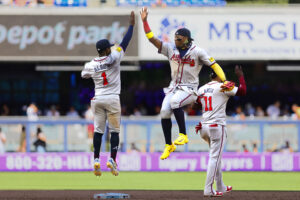Shohei Ohtani. Mike Trout. Two teammates who happen to be the best players in baseball. This matchup feels like something only possible in a video game or a child’s imagination but baseball fans rejoiced at the high-stakes at-bat between the two superstars in the last out of the World Baseball Classic championship game. Not only was this matchup the dream of every baseball fan but also a beautiful example of the intricacies and strategies that happen in every at-bat. Here’s a pitch-by-pitch breakdown of the climactic Ohtani vs. Trout showdow
🚨 MIKE TROUT VS SHOHEI OHTANI IS HAPPENING! 🚨#WorldBaseballClassic on @FS1
— MLB (@MLB) March 22, 2023
Ohtani vs. Trout: Inside an Incredible At Bat
The First Pitch: 1-0
The first pitch of the at-bat begins with Ohtani throwing a slider that barely ducks under the plate. The lateral movement of the pitch is incredibly noticeable, with the ball arcing like a frisbee toward the plate.
This pitch establishes Ohtani’s game plan: attack, attack, attack. The slider barely missed the bottom of the zone. While Japan’s catcher set up outside, Ohtani may have been trying to spot this pitch for a strike. Despite his high-octane fastball, Ohtani’s slider is by far his best pitch. This slider, categorized as a sweeper by Baseball Savant, recorded the second-highest pitch run value in the major leagues in 2022. Not only is this Ohtani’s nastiest pitch, but it’s also his favorite, which he threw 37% of the time last year. As the count gets more competitive, we’ll see Ohtani return to this pitch.
Trout on the other hand demonstrated his elite plate ability. Down in the ninth inning, with pressures running high, Trout was able to lay off a pitch that barely managed to dart out of the zone. In the last year, we’ve seen Trout’s strikeout rate and whiff rate increase dramatically. Therefore, the key for Trout in this at-bat was doing his best to avoid swinging and missing at Ohtani’s sweeper.
Pitch Two: 1-1
On an 0-1 count, Ohtani lets loose with a four-seam fastball. The ball screamed to the plate at 100 miles per hour, generating a swing and miss from Trout.
On paper, the movement of Ohtani’s four-seam isn’t great. Compared to the rest of the league, Ohtani’s fastball drops 1.7 inches more than average. However, this lack of movement is offset by Ohtani’s pure power, pushing the pitch past the barrel of Trout.
Despite missing, Trout’s swing looked intimidating. While Trout’s whiff percentage on fastballs increased in 2022, so did his HardHit%. Trout crushed fastballs last season with an average slugging percentage of .534 on the pitch. While this pitch happened to get past him, in an alternate universe, this fastball was crushed to tie the game.
Pitch Three: 2-1
This pitch is by far the most interesting of the at-bat. At first glance, it looks like Ohtani missed his spot on his four-seam. When we rewatch the pitch, however, we can see that the ball had lateral movement similar to a cutter. While Ohtani is known to throw a cutter, the 100-mile-per-hour velocity of this pitch indicates that this cutting action was not intentional.
Instead of throwing a pure cutter, Ohtani most likely accidentally altered his wrist or fingertip pressure on his four-seam fastball. While the pitch ends up as a ball on the outside part of the plate, this accident on the part of Ohtani highlights the intensity and emotion of this potentially game-sealing at bat.
Even by accident, this pitch was filthy. This cut fastball started at nearly the center of the plate before diving out at the last second, all while going 100 miles per hour. It would be interesting to see if Ohtani continues to try and cut his fastball while pitching for the Los Angeles Angels this season.
Pitch Four: 2-2
Pure attack mode. Ohtani simply willed this fastball behind Trout’s bat, throwing it at 100 miles per hour right down the middle of the plate. Honestly, seeing Ohtani triple up on fastballs was surprising considering his preference to throw sliders. Perhaps Trout was expecting a slider after seeing two fastballs back to back.
Pitch Five: 3-2
This is where the mind games of baseball emerge. Despite it being a 2-2 count, Ohtani has the advantage after blowing two strikes right past the three-time AL MVP. Does Ohtani quadruple down on a fastball? Does he throw his sweeper? Or does he throw a splitter that Trout struck out on previously?
Ohtani decides to quadruple up. Japan’s closer reached back for something extra as he spiked a 102-mile-per-hour fastball straight into the dirt. Clearly, Ohtani was trying to run another one right past Trout but may have been trying too hard to hit triple-digit heat.
The most fun part of this at bat is the mutual respect. From Ohtani throwing his best stuff, to Trout nodding in admiration, even Ohtani’s spiked fastball shows his attempt to throw his best pitch to get Trout out.
Pitch Six: 3-2
Full count, ninth inning, two outs, the situation every kid dreams of. This is the count you see in movies before a slow-motion walk-off or a triumphant strikeout over the villain. Ohtani vs. Trout. The best of the best.
Ohtani finishes the at-bat by slinging a slider that sweeps over the plate and ends up almost in the other batter’s box. Trout swings and misses, narrowly fouling the pitch off with the end of his barrel into the catcher’s mitt. And just like that, the game is over.
At the end of the day, baseball is an unfair game. Statistically, the odds of getting a hit or getting on base are much lower than the odds of getting out. With a strikeout pitcher on the mound and an all-around player at the plate, not only was this a perfect ending to an amazing World Baseball Classic, but also an amazing individual matchup.
Main photo credits:
Kirby Lee-USA Today Sports
Players mentioned:






